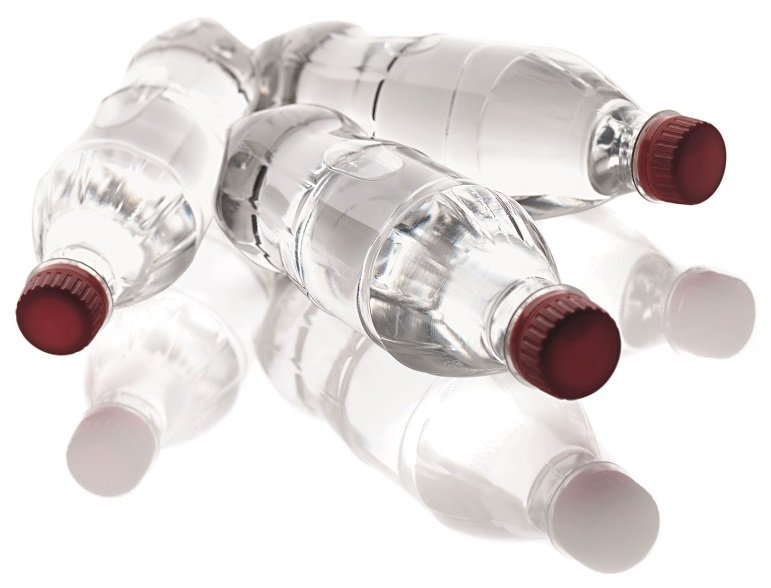Additives, plasticisers and other myths
In public debate, plastic packaging is often associated with harmful plasticisers. Countless warnings can be found online: plastic drinks bottles should not be left in cars in the summer because the heat can cause toxic substances to be released into the liquid. In addition, baby bottles allegedly contain the highly toxic bisphenol A (BPA) and should therefore not be used under any circumstances.
Is that so? Which substances can really be found in plastic products? And just how harmful are they?
Plastics at ALPLA
As a rule, ALPLA does not use or add harmful additives when manufacturing its packaging solutions. The type of plastic used most frequently by ALPLA is PET (polyethylene terephthalate). PET is transparent and is highly suited to use as packaging for foods and liquids. No harmful additives are needed to manufacture PET – and certainly not any plasticisers.
The accusation is frequently levelled, however, that PET packaging contains acetaldehyde and that this is passed on to the food in harmful amounts. This is not the case. Acetaldehyde is a natural substance that occurs as an intermediate in many biological processes. For example, acetaldehyde can be found in foods such as fruit, fish and cheese, and sometimes has a major part to play in creating a fruity and aromatic flavour. It is also a by-product of alcohol being metabolised in the human body. High doses can be harmful to the organs – but this equally applies to various day-to-day substances such as salt and pepper. The amount of acetaldehyde released by PET bottles is far below the statutory threshold of 6 mg/l. Many beverages have a much higher acetaldehyde concentration due to their production processes – in fruit juices, and it can range from 0.3 to 50 mg/l, and in wine, and it can be between 7 and 142 mg/l. Only in water is the release of acetaldehyde by PET bottles detectable – but at such a low concentration that there is absolutely no cause for concern.
We frequently use two other plastics alongside PET due to their material and processing properties: high-density polyethylene (HDPE) and polypropylene (PP). Neither of these two plastics requires the addition of plasticisers.

The hazards of plastics – then and now
So how did the rumour that plastic packaging is harmful come about? Decades ago, a lot of packaging was made out of polycarbonate (PC) and polyvinyl chloride (PVC), and it was not known that these materials could release harmful substances into the packaging content.
To make conventional PC, you need BPA, a synthetic substance with a hormone-like effect. This plastic was once used to make drinking bottles for infants. However, the production and sale of baby bottles containing BPA have been banned in the European Union (EU) since 2011, with the alternatives being PP or BPA-free PC.
However, BPA has not been completely eliminated from our lives: one source of BPA which is highly prevalent in our day-to-day lives is the thermal paper used for till receipts. But the EU has already taken steps here, and thermal paper with a BPA content of 0.02 per cent by weight or higher will be banned as of January 2020. BPA can also release epoxy. Among other things, this is used to prevent corrosion on the insides of metal tins, and that includes tins of food. There are approved alternatives, but it is not yet clear whether these are less harmful to health.
Then, as now, PVC only contains plasticisers if the end product needs to be soft and flexible. Phthalates such as DEHP are especially suited to use as plasticisers for PVC. But as some phthalates can influence humans’ hormonal balance, the EU has broadly banned many of them not only from food packaging, but also from children’s toys and cosmetics.
Protection from the lawmakers
The European Commission and numerous institutes have spent the past few decades taking a very close look at the effect that plastics can have on health. The laws derived from this stringently regulate the chemical properties that are permissible and what may be used for food packaging materials. Consumers in the EU therefore enjoy protection from BPA and other harmful substances in plastic food packaging and many other plastic products – as long as these laws are equally observed by the importers.
The debate surrounding plasticisers and additives is often founded on outdated or incorrect information. We recommend the following websites as reputable sources of information:
Do you like our texts? Perhaps even so much that you want to use them in your own media? Then please get in touch with us beforehand!

